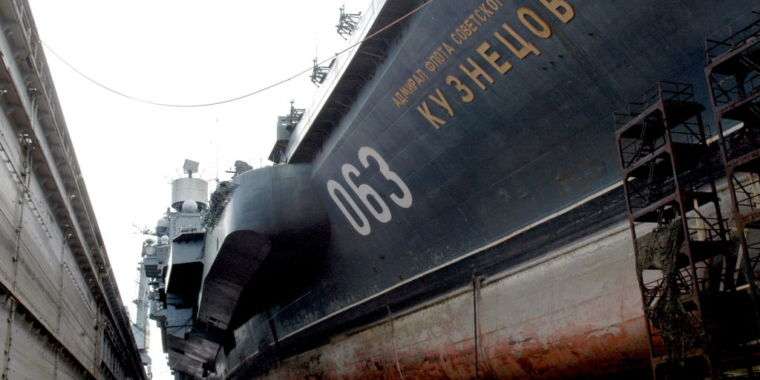
Russia’s only aircraft carrier damaged as its floating dry dock sinks

-
The Russian aircraft carrier Admiral Kuznetsov at the PD-50 floating dry dock of Shipyard 82 on a previous visit to the yard in 2006. The PD-50 floating dry dock of the shipyard sank while the Russian aircraft carrier Admiral Kuznetsov was leaving it on the night of October 29 to 30, 2018.
-
A full view of the PD-50 carrying the Kuznetsov on August 7, 2010. The PD-50 is one of the only dry docks large enough to handle the Kuznetsov‘s 55,000 metric ton (54,000 long tons; 61,000 short tons) displacement.
-
The Kuznetsov was flagship for a Russian Navy task force sent to attack Islamic State (ISIS) militants in Syria. Here, it is seen on one of its better days (not belching black smoke).
Russia’s one and only aircraft carrier, the Admiral Kuznetsov, is in the middle of a long-forestalled refit in Murmansk. But its repairs may take a bit longer now that the floating dry dock that was carrying it at Murmansk’s Shipyard 82 suddenly sank—causing a giant crane to crash onto the Kuznetsov and gash a 16-foot hole in its hull. One shipyard worker is missing, and four others were hospitalized—two of them in critical condition.
The floating dry dock, the PD-50—one of the largest in the world—apparently sank as the result of a power outage following a power surge at the shipyard, possibly related to damage to power lines caused by ice.
According to the press officer of the Zvezdochka Ship Repair Center, Evgeny Gladyshev, the accident occurred while the Kuznetsov was being floated out of the dock. “When the 82nd Shipyard was launching the Admiral Kuznetsov, an emergency situation occurred,” Gladyshev explained to Interfax. “Due to interruptions in the supply of electric power to the PD-50, the floating dock dived out in an off-design mode.”
Without power to control the pumps or control the filling of the ballast tanks, the dry dock completely submerged. In the process, a 70-metric-ton (77-US-ton) crane crashed into the ship as it floated out of the sinking dock. Another crane fell as well.
The Kuznetsov—officially designated as a “heavy aircraft-carrying cruiser”—was the only aircraft carrier completed by the Soviets. Originally launched in 1985 but not commissioned until 1990, the Kuznetsov has had a checkered history. Its sister ship, originally named the Riga by the Soviet Union and then later renamed the Varyag, was still under construction in Ukraine at the end of the Soviet era and was eventually sold to a Chinese company that claimed it would be used for a floating hotel. That company turned the Varyag‘s hull over to the People’s Liberation Army Navy, and it became PLAN’s first carrier.
Propelled by notoriously unreliable oil-burning turbo-pressurized boilers and steam turbines—the Kuznetsov had so many propulsion failures that it had to be accompanied by a seagoing tug just in case—it drew ridicule as it steamed through the English Channel belching black smoke on its way to Syria in 2016 and then back north in 2017. The UK’s defense minister at the time, Michael Fallon, called the Kuznetsov the “ship of shame.”
Fires, oil spills, and landing deck accidents—including a snapped arresting wire that caused a landing Sukhoi Su-33 fighter to roll off the end of the deck and into the ocean—have only enhanced the Kuznetsov‘s reputation as a bad-luck ship. The Kuznetsov‘s fortunes clearly followed it into the shipyard. Replacement of the failing components of the ship’s propulsion system and other critical systems—including the ship’s plumbing, which lacks weatherproofing and is shut down in cold weather to prevent freezing—was already anticipated to take up most of the $400 million budgeted for the Kuznetsov‘s modernization after the Russian Navy’s original upgrade budget was halved by the Defense Ministry, according to Interfax.
The unloading of turbo-pressurised boilers from aircraft carrier RFS ‘Admiral Flota Sovetskogo Soyuza Kuznetsov’.Shipyard of 🇷🇺#Murmansk, #Russia. July 2018. Photo by ©花落成蚀 pic.twitter.com/Sqos1VBNNZ
— Capt(N) (@Capt_Navy) July 22, 2018
And then the dry dock sank. Whether or not the PD-50 itself can be salvaged is currently unclear, as it was heavily damaged during its sudden sinking. “Even if this is technically possible, the operation will not be easy and, most probably, very expensive,” a spokesman for the shipyard said. And the PD-50 was the only floating dry dock in Russia’s western region capable of floating the Kuznetsov; another large floating dry dock, the PD-190, is at Novorossiysk on the Black Sea.
In the meantime, Russia’s TASS news agency reports that the Kuznetsov has been towed to another shipyard on the Kola Bay—the 35th Shipyard, also in Murmansk. A Defense Ministry spokesperson said that the accident won’t affect the repair schedule and that the ship is still expected to return to service in 2021. “At present, a detailed examination of the material part of the ship has been launched to identify possible damage,” Interfax quoted an official as saying. “According to initial estimates, the ship did not receive any significant damage that could affect the timing of repairs.”
Listing image by Getty Images




